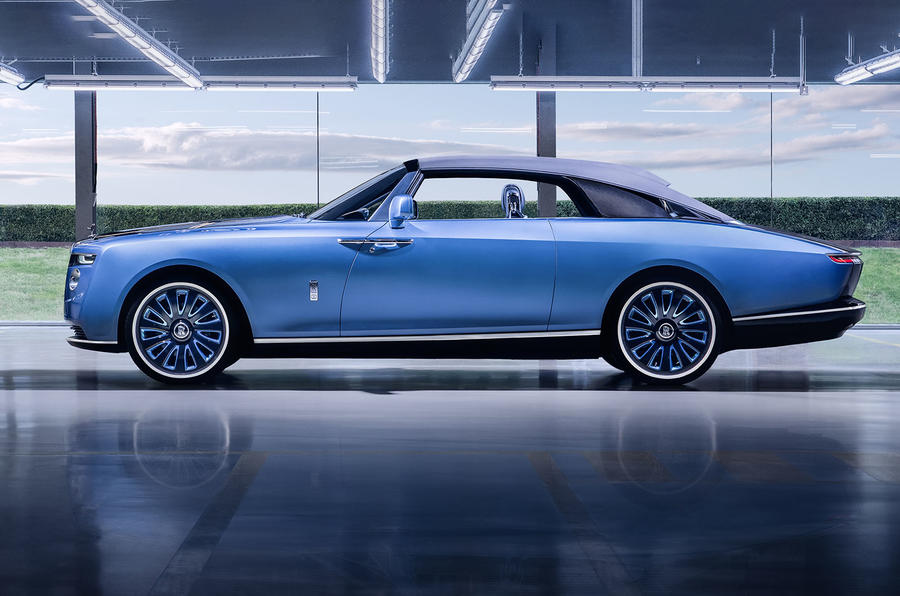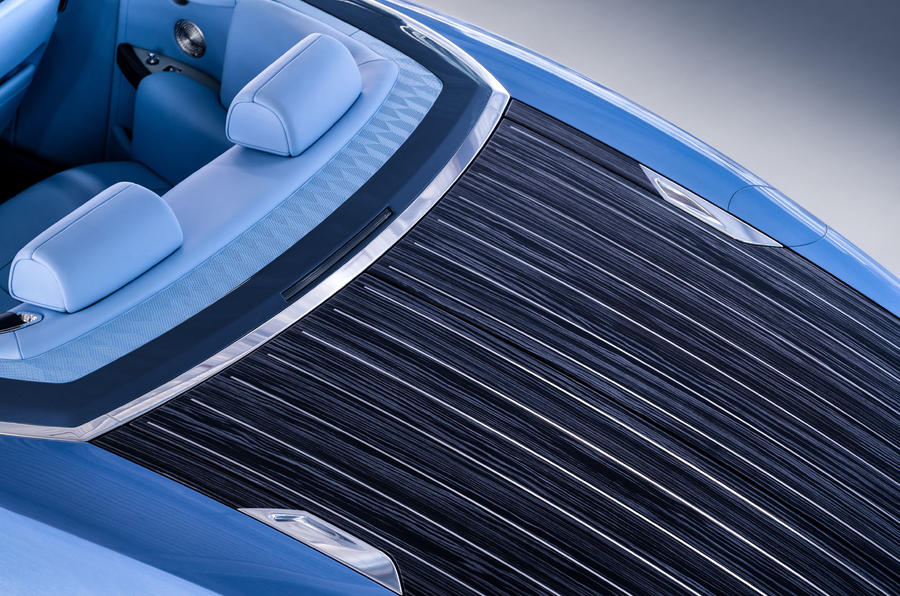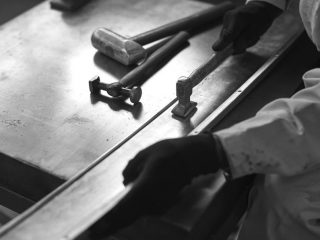Only three Boat Tails will be built. The man behind it explains why.
The Rolls-Royce Boat Tail is the firm’s latest ultra-exclusive coachbuilt creation, and just three examples of the machine will be produced.
While the general styling of the three cars will be familiar, each model will be heavily customised to the specifications of its buyer.
Alex Innes, Rolls-Royce’s head of Coachbuild Design, gave an exclusive tour of the first Boat Tail machine to be revealed to highlight some of the key features – including a unique pop-up parasol, two working fridges and handbuilt matching timepieces.
Q. How did the design process work over the four years?
A. “We followed a normal design process: we built full-size clay models and invited the clients in to see them at differing stages.
“When some brands talk about bespoke, it’s very much after the fact and they’re guiding clients towards predetermined options. For us, such was the strength of the relationship that we were comfortable bringing them into the studio when the project was in its absolute infancy; and we didn’t have a crystallised view of what it would be.”
Q. How similar will the Boat Tail cars be to one another?
A. “The bodystyle is the only similarity between the three. If we wanted to do a modern Boat Tail, it needed to be more than one: when you look back at coachbuilding in the late 1920s, there was usually more than one. We felt three was the natural limit to safeguard that absolute exclusivity. [The clients] were heavily involved in shaping the design of the car, but the appointment of the cars, the details and the provisions of the rear hosting area vary considerably.”

Q. How hard were aspects such as the parasol to develop?
A. “These lovely little quirks really tried the patience of our engineering and technical colleagues. The parasol is a very Rolls-Royce solution. We could have done this by finding certain quicker and more modest ways to do it, but this really needed to be the very, very best and deliver a ‘wow’ factor when the client was using it.”
Q. Which is your favourite feature of the Boat Tail?
“The very fact it exists. In a world of instant gratification and immediate fulfilment, to have the time, space and freedom to assemble something that will mark a moment in history for the brand was extraordinary and a privilege to be a part of.”
Q. What do the Boat Tails say about Rolls-Royce’s future?
A. “We’re don’t necessarily work to a scale of volume, more to a scale of scope. As for this post-opulence movement, there’s a very different positioning between conspicuous consumption – which is broadening what you do today – and this, where you elevate in a completely different direction and create something more profound.
“We believe the future of luxury is singular: it’s about creating singular moments and objects that connect with the patron in a way that’s hugely powerful.”
The Rolls-Royce Boat Tail in detail
Side profile and roof: The side profile is designed to invoke nautical references, particularly the wraparound- style windscreen and tapered rear. The removable canopy has a sweeping profile that extends over the rear deck.

Innes said: “We wanted to give the car a distinct personality with the roof on, because all coachbuilt cars should be distinctive. The flying buttresses create a dramatic silhouette.”
A temporary tonneau cover is provided inside the car for use in case of inclement weather when the roof is removed.
Bodywork and colour: Every body panel on the Boat Tail is unique and has been hand-formed from aluminium. The side panel is the largest yet fitted to one of the firm’s cars.
“To our knowledge, nobody else is taking these historic coachbuilding techniques and applying them to modern design,” said Innes. “We wanted to take these techniques and efforts of the finest craftspeople to create a future vision for the brand.
“The almost flawless nature and general quality, fidelity and precision is something we could never achieve through industrialised techniques.”
Innes said he kept the bodywork styling deliberately minimal, explaining: “Cars that sit in this space often work to this metric of more is more – almost a hyper-characterisation of the brand it represents. But we wanted to create a purer, more distilled representation. We wanted to rely on the overall proportions and scale of the car to create that overall impact.”
The metallic blue paint chosen by the client was refined so that it would become ‘animated’ in varying levels of light. Innes joked: “The colour was the only constant throughout the whole project.”
The bonnet features a graduated black colour running down to the grille.
Front end and grille: The Boat Tail has a unique interpretation of Rolls- Royce’s Pantheon grille, set back into the bodywork.

“It’s deconstructed into the car, and the component elements of the grille now form part of the structural integrity of the front end,” said Innes. “It’s no longer simply decoration; it’s now part of the heart and soul.” To ensure that the car still had a “familiar sense of authority”, Innes added revamped headlights and a thick ‘eyebrow’ line of LED daytime-running lights to “give a heavy brow feeling”.
“It’s still bearing down on you, as you would expect from a Rolls-Royce,” concluded Innes.
Rear deck and hosting suite: The distinctive rear deck for which the Boat Tail is named features styling inspired by J-class yachts.
Each of the cars built has a custom fitting chosen by the client. On the car seen here, the automatic opening mechanism gives access to two storage panniers that extend at exactly 15deg, plus two fold-out tables.

One side is devoted to aperitifs and champagne, including a special store that was custom-designed and colour-matched to a bottle of Armand de Brignac, along with custom-built bottle stoppers, an ice bucket and tongs. The other side is given over to food storage and dining, including a set of crockery and cutlery created by Christofle and engraved with the Boat Tail name.
Innes said: “We installed two full fridges in the back, not chillers as you would normally find, guided by the client’s specification of the duration of journey they would use the car for.
We also have custom-built salt and pepper grinders – not shakers, because the client asked: ‘When have you ever been to a Michelin- starred restaurant and used a shaker?’”
Parasol: The most unusual feature of the Boat Tail is an extending parasol, designed to offer shade during picnic lunches.
“It’s something never seen on a motor car before,” said Innes, “but it seemed a logical extension of our limousines that have umbrellas in their doors. This car is all about enjoying the high life, so we need to offer provision for if you’re under the midday sun.”
The parasol deploys from a cylinder that runs into the rear deck and is extended by a mechanical system. The deployment is inverted so that the parasol opens like a flower and can therefore be done from close to the unit.
Innes added: “That was the last detail to be finalised on the car, and it’s a complete ground-up development. The stays are carbonfibre. We even had to develop the right tension of fabric.”
Dashboard: The dashboard fascia is deliberately pared back and was customised to fit the client’s requirements and preferences.
“We wanted to hide the technology that would anchor this car at any point in time, knowing that it should make its debut in concours events in 50-100 years from now,” said Innes.
The wood design from the rear deck is carried through the cabin, which features metallic dark- blue leather upholstery and blue elements woven into the bodywork.
The centrepiece is the clock unit, which houses a matching pair of reversible Bovet wristwatches. Each can be inserted into the display unit while the other is stored in a special compartment. Innes described this aspect as “unlike anything accomplished before”.
“The client typically wears bespoke timepieces that are inherently heavy,” explained Innes, “and didn’t like the idea of wearing it while piloting the car but disliked hiding it in storage.
“We therefore worked with Bovet’s technical team to create a floating mechanism that allows [the watch] to slide into the instrument panel.”
The watch’s internals had to be extensively reworked to cope with the magnets of the car and vibrations it would suffer when in place. The straps for each watch feature a design with the silhouettes of the new Boat Tail and the 1932 Boat Tail that the client also owns.
Audio system: Rolls-Royce’s 15-speaker Bespoke stereo had to be re-engineered for the Boat Tail.
On other models, a hollow section of the sill is used as a resonance chamber for the bass speaker, but this section couldn’t exist in the Boat Tail. Instead, the entire floor is used to resonate the bass, ensuring the surround-sound works even when the roof is down.
James Attwood






